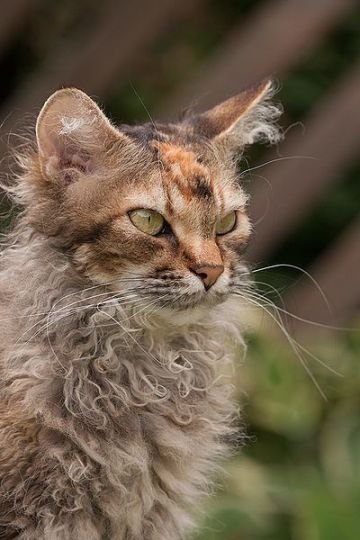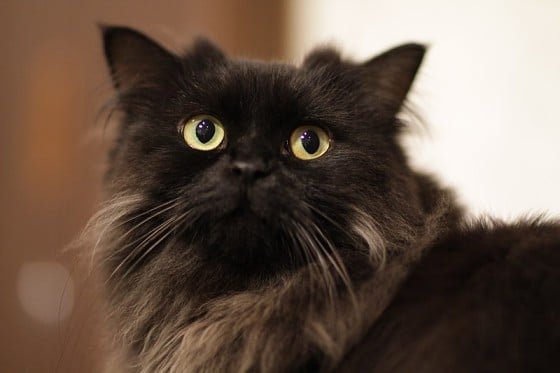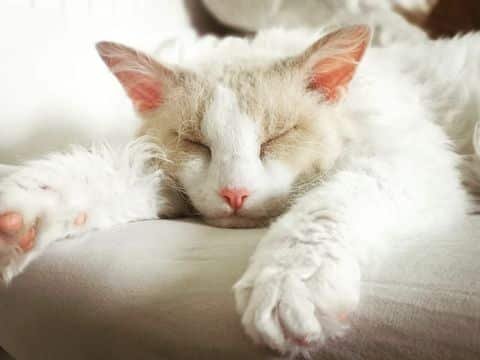If you are old enough to remember the 80s, you probably shudder when you remember the fashion and hairstyles from that decade. The more hair, the better – at least that was the slogan those years, and many people got perms to make her hair curly and voluminous.
Fortunately, that trend is behind us, and hopefully, it won’t come back anytime soon. However, one cat breed still rocks perm-like curls even today, and these cats look way better than people in the 80s. I am talking about LaPerm cat breed, and there are many interesting things about these cats, so keep reading to learn more!
LaPerm Cat Characteristics
Appearance
| Fur color | Any genetically possible color, including gray, black, white, brown, yellow, silver, blue, lilac, fawn, cream, orange, sable, red, etc. |
| Fur pattern | Solid, bi-color, calico, tabby, and tortoiseshell |
| Fur length | Short and long, with distinct curls and waves |
| Eye color & shape | Medium-large almond shape eyes that become rounder when the cat is alert, and eyes can be of any color, including green, blue, hazel, yellow, copper, cold, and orange. |
| Length | Males 12”-18” Females 10”-16” |
| Weight | Males 6-10 lbs Females 5-8 lbs |
| Expected lifespan | 12-15 years |
Personality
| Temperament | Friendly, affectionate, curious, active, playful, easy to train |
| Kids and other pets | Friendly towards kids and other pets |
| Sociable and cuddly | Sociable and cuddly cats that are also friendly toward strangers |
Requirements & Traits
| Feeding | Meat-based food rich in protein, both wet and dry food, adults should eat 2-3 times a day, while kittens and juveniles need to eat 3-4 times a day. |
| Grooming | Weekly brushing or combing to prevent matted fur full of knots. Occasional bathing is recommended if the cat gets dirty. Nail trimming, eye cleaning, ear cleaning, and teeth brushing are also necessary. |
| Shedding | Moderate but infrequent |
| Hypoallergenic | No |
History and Origins

Many new cat breeds originated due to specific genetic mutations. For example, most bald cat breeds were either born bald due to genetic mutation, or they were born with hair that fell out after birth due to the same genetic mutation.
However, for the first LaPerm cat, this process was the opposite. In 1982, on an Oregon farm, a bald female kitten was born. Soon enough, the kitten started growing soft and curly fur, so she was named Curly by her owner Linda Koehl.
As Curly grew up, she had several litters, and many of her kittens had the same curly fur. Koehl was intrigued by this, so she researched breeding and genetics. After trying out the controlled breeding, Koehl discovered that the gene mutation responsible for curly hair was dominant and carried by both males and females.
She took her cat to cat shows and attracted a lot of attention. Eventually, Curly disappeared since she was an outdoor cat, but her descendants got recognized as a new cat breed called LaPerm.
LaPerm Cat Personality
LaPerm cats are an extremely curious cat breed, and they like to follow their owners around. They will often hop on their owner’s shoulders to get a better view of whatever is happening. LaPerms love to be included in everything, so don’t expect to enjoy much alone time.
LaPerm cats also love heights, if left outside, they will often climb trees, roofs, and other high places. This is an active cat breed, but LaPerms are also cuddly and affectionate. If they see a chance to cuddle with you and just enjoy your company, they will gladly stop their playing session and come to you.
LaPerms love physical contact with their owners, and they will often touch your face with their paws or bop their heads against yours.
If properly socialized from an early age, LaPerm cats will be friendly towards kids, other pets, and even strangers. However, LaPerm cat gets along better with older children than with toddlers because toddlers often pull its curly fur.
LaPerm cats are intelligent and playful, and they enjoy playing various games either with their owners, other pets, or alone with their toys.
LaPerm Cat Appearance

Although they have beautiful personalities which make them perfect pets, LaPerm cats are beloved among cat enthusiasts mostly due to their unusual appearance.
Fur
Their fur is what makes LaPerm cats so special. Most LaPerm cats are born with no hair at all, or their fur is short. As they grow up, their fur also grows, and it becomes wavy and/or curly. When fully grown, the fur can be of any length, and it will be of different lengths on different parts of the body.
When it comes to color, LaPerm’s fur can be of any genetically possible color. This includes black, brown, gray, white, orange, red, lilac, blue, fawn, sable, cream, and other color variations.
Additionally, LaPerm’s fur can also come in every pattern possible, including solid, bi-color, calico, tabby, tortoiseshell, etc.
Longhaired LaPerms have silky soft, loose, and bouncy fur, while shorthaired ones have a more firm, dense, and less bouncy fur. Also, longhaired LaPerm cats have ruffs around their neck, ears, and tail. Shorthaired LaPerm cats have no ruffing.
Eyes
LaPerm cats have medium-sized eyes that are usually almond-shaped but can get rounder when the cat is alert. These eyes are also moderately set apart, slightly slanted, and expressive. Any color is possible, including blue, green, aqua, yellow, orange, hazel, copper, gold, etc. The eye color doesn’t depend on the coat color.
Size
LaPerms are medium-sized cats, with males being slightly larger than females. Male LePerms usually weigh 6-10 pounds, and their body length ranges between 12 and 18 inches. Females, on the other hand, weigh 5-8 pounds on average, with their body length ranging between 10 and 16 inches.
Other Body Characteristics
LePerm’s body is moderately muscular and medium-boned. The hips are taller than the shoulder area because the hind legs are slightly longer than the front legs. The paws are proportionate to the rest of the body and rounded. The tail is proportionally long and tapered.
The head has a rounded and wedged shape, with full and round whisker pads, a broad muzzle, and a strong chin. Ears are medium to large and slightly flared and cupped. Longhaired LePerms have tufted ears, while shorthaired ones usually don’t.
Daily Life With LaPerm Cat
Although they might look high-maintenance, LaPerm cats are actually not so demanding, and you only need to follow some general tips on LaPerm maintenance.
Feeding
Just like other domestic cats, LaPerm cats are carnivores, which means they require meat-based food in both wet and dry forms. A healthy diet for LaPerm cats includes lots of proteins and moderate amounts of fats.
Kittens and young LaPerms need to eat more often because they are still growing. For them, the recommended feeding frequency is 3-4 times per day. Adul LaPerms should eat 2-3 times per day, but their portions should be bigger than with kittens and juveniles.
The exact portion size depends on the size and age of your cat, and your vet will be able to give you a better estimate. The rule of thumb says that the adult 10lbs LaPerm cat should eat 250 calories per day. Occasional snacks are recommended but don’t provide them too often, as it can lead to obesity.
Grooming
Surprisingly enough, LaPerms curls don’t get tangled as often as you would expect. However, they need to be combed or brushed weekly to prevent knots and matting. These cats clean themselves quite well, but you can bathe them every few months or if they get dirty.
Dental hygiene is also important. If possible, teach your LaPerm while it is still a kitten to tolerate teeth brushing. If that wasn’t possible for some reason, give it some teeth-cleaning treats. Trim your LaPerm cat’s nails once every two weeks. Clean their ears and eyes every few weeks or if they get noticeably dirty.
Activity
Since LaPerm cats descended from highly active barn cats, they still need loads of activity and exercise to stay healthy, fit and entertained. Their hunter’s instincts are still strong, so they love to play chasing games. They also like to play with toys and pretend it is their prey, so provide them with enough fake mice, balls, and similar other playthings.
When possible, take some time out of your day to play with your LaPerm. It will be a great opportunity for bonding, and your cat will certainly appreciate it. It will also be great exercise for you, and it might help you relax after a long day.
Since LaPerm cats are highly sociable and like having company, try not to leave them alone for too long. You should consider getting another cat or a cat-friendly dog if you have to leave your home every day for more than 1-2 hours.
Most Common LaPerm Cat Health Issues

LaPerm cats are healthy in general, and they aren’t prone to some congenital conditions and genetic disorders. However, it is natural that every living being gets sick eventually, and LaPerm cats aren’t an exception. Let’s take a look at some of the most common health issues among LaPerm cats:
Obesity And Diabetes
Sometimes, it can be hard to be strict when it comes to feeding your cat. Most cats are quite greedy, and they will beg for food even if they ate a few minutes ago. Cat owners want to make their cats happy, and one way to do it is to give them treats.
However, this can lead to obesity, which in turn, can cause diabetes. We all know that human diabetes can be dangerous and even life-threatening, and the feline version of this disease is far from harmless either.
Some cat breeds are more prone to obesity and diabetes than others, but every cat can become obese if it eats too much and moves too little. LaPerm cats, just like other highly active cats, are naturally wired to hunt for their food.
That way, cats spend most of their daily calorie intake chasing their prey. However, since house cats don’t actually need to hunt for their food, they don’t spend as many calories as their ancestors. Some cats will regulate their appetite and eat less, but most cats don’t have that level of self-control.
To prevent this from happening, first, make sure that you aren’t giving too much food to your cat. Then, make sure that your cat has enough exercise and activity. Don’t forget to consult your vet, as they will be able to recommend how much food vs. exercise your cat needs.
Feline Immunodeficiency Virus (FIV)
One of the most common infectious feline diseases, the feline immunodeficiency virus affects LaPerm cats too. It is transmitted through the bite of the infected cat, and once it enters the bloodstream, it attacks the immune system.
Cats with FIV suffer from immune deficiency, which makes them more susceptible to various other infections. Cats that are FIV positive can live just as long as healthy cats, as long as they don’t succumb to other conditions, such as feline leukemia.
There is no cure for FIV, but with regular vet checkups and prevention and treatment of other conditions, your FIV-positive LaPerm cat can live a long and happy life.
Skin Yeast Infections
Apart from protecting the cat from cold and elements, its fur has another important function. The skin exudes oils which are then absorbed by hairs from the fur. When there is no fur to absorb these oils, the skin can become greasy. As a result, greasy skin is more prone to developing yeast infections.
Since many LaPerm cats are born bald, they can develop yeast infections until their fur grows dense enough to collect the oils from the skin. If you notice any type of rash or strange patches on your cat’s skin, take it to the vet. This condition is easily treatable, you just need to react fast until it gets more serious.
Hip Dysplasia
Hip dysplasia is another condition that affects many cat breeds, including the LaPerm cat. Basically, the ball and the socket of the hip joint get misaligned, which prevents smooth movement of the cat’s legs. Some milder cases go unnoticed, and the cat leads a seemingly normal life.
However, in more severe cases, the cat’s mobility is significantly reduced, and it can be quite painful. In this case, the cat will move less than usual, avoiding sudden movements, running, and jumping. It might even try to lick or bite the affected hip in an attempt to reduce the pain.
If you notice any of those things, or if your cat is limping or walking in a weird way, take it to the vet. The vet will be able to determine the best treatment.
Hypertrophic Cardiomyopathy
Feline hypertrophic cardiomyopathy is a genetic condition in which the heart’s wall muscles get abnormally thick. As a result, the heart’s efficiency is significantly reduced, and it needs more oxygen than usual.
This can lead to oxygen starvation and blood clot formation, which can cause arrhythmia and heart failure. It is worth noting that not every cat with hypertrophic cardiomyopathy will go through all these consequences.
However, if you notice your cat showing some typical hypertrophic cardiomyopathy symptoms (lethargy, loss of appetite, rapid heart beating, etc.), make sure to take it to the vet immediately.
LaPerm Cat Name Suggestions
Special cats like LaPerm names deserve some carefully selected and special names. Here are some of my top picks:
- Arthur
- Annie
- Bowie
- Bon Jovie
- Chase
- Dorry
- Gabriel
- Keira
- Leo
- Maggie
- Oscar
- Rufus
- Tristan
Buying or Adopting a LaPerm Cat
LaPerms are a quite uncommon cat breed, which makes it unlikely that you will find one for adoption in a shelter. These cats are so rare that not many breeders are selling them. If you live in a small town, chances are, none of the local breeders will have LaPerm cats to sell you.
However, in big cities, it is possible to find cat breeders specializing in LaPerm cats. The price ranges from $300-$1300, but some sources claim that LaPerm cats can be sold for up to $12000! I think you will agree with me that such a price is insane, but obviously, some people think it’s worth it.
No matter how much you pay for your LaPerm cat, make sure that you buy it from a reputable breeder. Also, if you buy LaPerm kittens, keep one thing in mind. Not every LaPerm kitten will grow curly fur, some will actually grow “normal” fur instead.
If your main reason for buying a LaPerm is to have a curly cat, you should look for cats that are at least several months old and whose fur has already grown. This way, you will make sure that you are actually getting a curly cat.
LaPerm Cat Alternatives
While LaPerm cats are adorable, they can be a bit hard to find in the US. Or, you maybe wonder if there are other curly cat breeds. The answer is yes, there are several curly cat breeds, and some of them are Cornish Rex, Devon Rex, Selkirk Rex, Tennessee Rex, etc. Basically, if the breed has “Rex” in its name, it is a curly cat!
If you don’t necessarily want a curly cat, you can choose some long-haired cat breeds instead. Persians, Birman, and Turkish Angora cats have similar bodies and body sizes as LaPerms, so they could be great alternatives.
Frequently Asked Questions
No, although they don’t shed as much as other cat breeds, LaPerm cats aren’t hypoallergenic as their skin still exudes proteins responsible for triggering allergies.
LaPerm cats are usually quiet, but they will sometimes meow, especially if they want attention.
If the dog is cat-friendly and your LaPerm is socialized from an early age to get along with dogs, they can become best friends!
The LaPerm cat breed comes from Oregon, United States.
LaPerms are medium-sized cats that can reach a weight of 10 lbs and a body length of 18 inches. Males are slightly larger than females.
LaPerm Cat Fun Facts
- Curly was the name of the first LaPerm cat, and its mother was a regular barn cat named Speedy. Speedy was a shorthaired gray tabby, while LaPerm’s father remained unknown.
- LaPerm isn’t the only cat breed with curly hairs, and such cat breeds are called “rex” breeds. Apart from LaPerm, other “rex” cat breeds are Cornish Rex, Devon Rex, and Selkirk Rex.
- Although it originated in Oregon, LaPerm is still extremely rare in the USA, and it is the 40th most popular cat breed in the USA, out of 43 breeds. Hopefully, this will change in the coming years, and LaPerms will get the deserved recognition.
Summary
LaPerm cats are still waiting for their breakthrough, after which they will become more widely spread and popular. Although most general population isn’t familiar with this cat breed, we true cat enthusiasts know how amazing LaPerm cats are.
Apart from rocking beautiful curls, LaPerm cats are loving, affectionate, playful, loyal, and intelligent pets. They get along with children, other pets, and even strangers. If you get yourself a LaPerm cat, you will get a best friend that will follow you around and keep you company.
They might be hard to find since they are a relatively obscure cat breed, but the effort is definitely worth it, as LaPerm cats are perfect pets for you and your family!
Featured Image Credit: Bebopscrx, CC BY-SA 3.0 https://creativecommons.org/licenses/by-sa/3.0, via Wikimedia Commons
